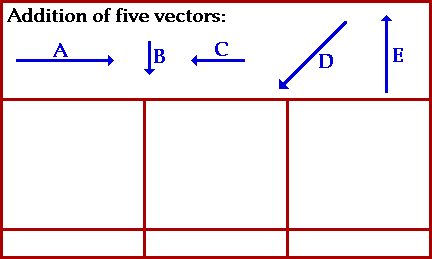
Vector Addition:
The Order Does NOT Matter
A GIF Animation
The summative result of two or more vectors can be determined
by a process of vector addition. The most common method of adding
vectors is the graphical method of head-to-tail addition. This method
involves the selection of a scale (e.g., 1 cm = 5 km), and the
subsequent drawing of each vector to scale in the specific direction.
The tail of each consecutive vector begins at the head of the most
recent vector. The resultant vector (the summative result of the
addition of the given vectors) is then drawn from the tail of the
first vector to the head of the last vector. The magnitude and
direction of the resultant is then determined using a protractor,
ruler, and the indicated scale.
The question often arises to the importance of the order in
which the vectors are added. For instance, if five vectors are added
- let's call them vectors A, B, C, D and E - then will a different
resultant be obtained if a different order of addition is used. Will
A + B + C + D + E yield the same result as C + B + A + D + E or D + E
+ A + B + C? The animation below provides the answer. Observe the
animation a couple of times and see what the answer is.

As shown in the animation above, the order in which two or
more vectors are added does not effect the outcome. Adding A +
B + C + D + E yields the same result as adding C + B + A + D + E or D
+ E + A + B + C! The resultant, shown as the green vector, has the
same magnitude and direction regardless of the order in which the
five individual vectors are added.
For more information on physical descriptions of motion,
visit
The
Physics Classroom. Specific information is available there on the
following topics:
This page was created by
Tom
Henderson of
Glenbrook South
High School.
Comments and suggestions can be sent by e-mail to
Tom
Henderson.
This page last updated on 11/17/98.
